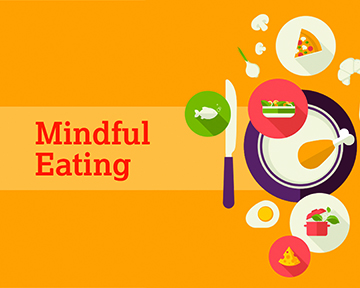 by Elizabeth Bravman, Nutritionist, Healthy Heart Ambassador, Cycling Instructor, YMCA of Metro Denver
by Elizabeth Bravman, Nutritionist, Healthy Heart Ambassador, Cycling Instructor, YMCA of Metro Denver
We all know that WHAT we eat is very important for our overall health. But did you know that thinking about WHY and HOW you eat can bring your wellness to a whole new level? Practicing Mindful eating can help us do just that.
The opposite of “mindful” eating is “mindless” eating. What is that?
- Have you ever eaten a quick breakfast in the car?
- Eaten lunch while doing work at your desk or dinner in front of the TV?
- Snacked right from a large bag or container while you scrolled through your phone?
If you answered yes to any of these questions, then you have mindlessly eaten. You are not alone. Most Americans practice some sort of disconnected eating every day. Food is part of our culture, and we have a distorted view of portion sizes. Plus, we love to multitask which is the perfect recipe for mindless eating. These habits can lead to overeating, weight gain and serious health risks.
Mindful eating can help us avoid the pitfalls of mindless eating and bring us back in touch with how and why we eat.
Stay connected by pausing and asking these three why and how questions:
- Am I truly hungry? Seems like an easy question but since we live in a toxic food environmen
 t that is constantly sending us external messages about eating, it can be difficult to tap into those internal cues of hunger. Sometimes it’s a clock telling us to eat, we see or smell food or we are in a social setting, and we eat regardless of being hungry.
t that is constantly sending us external messages about eating, it can be difficult to tap into those internal cues of hunger. Sometimes it’s a clock telling us to eat, we see or smell food or we are in a social setting, and we eat regardless of being hungry.
TIPS: Put sticky notes near your fridge, pantry, plates/bowls or silverware with this question written on it. Set up an alert in your phone that asks you this question. Often hunger can be confused with thirst, have a large glass of water while trying to decide!
- Am I satisfied? Satisfied — not full or stuffed. It takes about 20 minutes for hormones in your body to signal your brain that you are full. It’s best to stop eating when you first start to feel satisfied.
TIPS: Check in with yourself about halfway through your meal to see how you may be feeling on the satisfied scale. Take your time! Try placing your silverware down in between bites, use your non-dominant hand or chopsticks to eat to help slow you down. Set a timer for 20 minutes. If you finish before then and you think you might still be hungry, get up from the table, do dishes or take a walk, before checking in with yourself to see if you still might be hungry. If the answer is yes, then honor your hunger and eat more!
- Am I eating because I am sad, bored or stressed? Often, we eat because we are feeling something else and not hunger. Addressing these feelings directly will help avoid emotional eating.
TIPS: If you notice you want to eat because you have one of these occasional emotions, a swap can help you process the emotion. If you want to eat because you are bored some great swaps are going for a walk, listening to a podcast, calling/texting a friend or cleaning. A swap for stressed emotions may be exercise or venting to a friend. Sad or lonely? Call/text a close friend, journal, or try a warm bath or a funny TV show. It is important to note that if these emotions are intense and/or frequent, seek support from a health professional.
- Am I eating with distractions? With distractions we miss our internal cues of satiety and may overeat. Remove technology, work, reading materials, or other distractions while eating. Be present and focus on enjoying your food.
TIPS: Sticky notes or alerts on your phone to put away all distractions can help. Saying a blessing over your meal or acknowledging where your food has come from and how many hands were involved in bringing it to your table can also bring your focus to eating.
- Am I setting myself up for success with appropriate portion sizes? Portion sizes should not matter if you are paying attention to your internal cues but… we’re human and studies show that large portion sizes push people to overeat!
TIPS: Learn average portion sizes for you. Don’t eat directly out of containers or bags, portion into smaller plates and bowls. Using smaller plates and bowls will make you feel like you have more. Don’t forget to check in with yourself — some days the average portion size might be too much or not enough depending on what is going on in your life!
- Am I enjoying my food? Food should taste good, and eating should be enjoyable!
TIPS: Sit down and simply observe your food — its textures, colors, and smells. Chew slowly, noticing flavors and sensations. If you are in a group, it’s fun to experience this together, making observations and comparisons. Journal about your food. With children, it’s great to play games where everyone closes their eyes and describes their first bite in detail.
The act of pausing and bringing your attention to why and how you are eating may open your eyes to certain aspects of your eating that can be improved. Be curious in a non-judgmental way. Notice your answers and consider the factors influencing you.
Be gentle on yourself as you start to practice thinking about why and how you eat. Try to incorporate just one question into your day and make sure it’s one that feels doable to you right now. Try something like: “I will not use any technology or have any distractions during lunch on Tuesdays and Thursdays this week” or “I will not eat chips right from the bag on Friday nights.”
This is a lifelong practice with the goal of simply becoming more mindful at eating. The more you practice, the easier it gets.
If you need any nutritional support, the YMCA of Metro Denver’s nutrition team can be contacted through denverymca.org.
